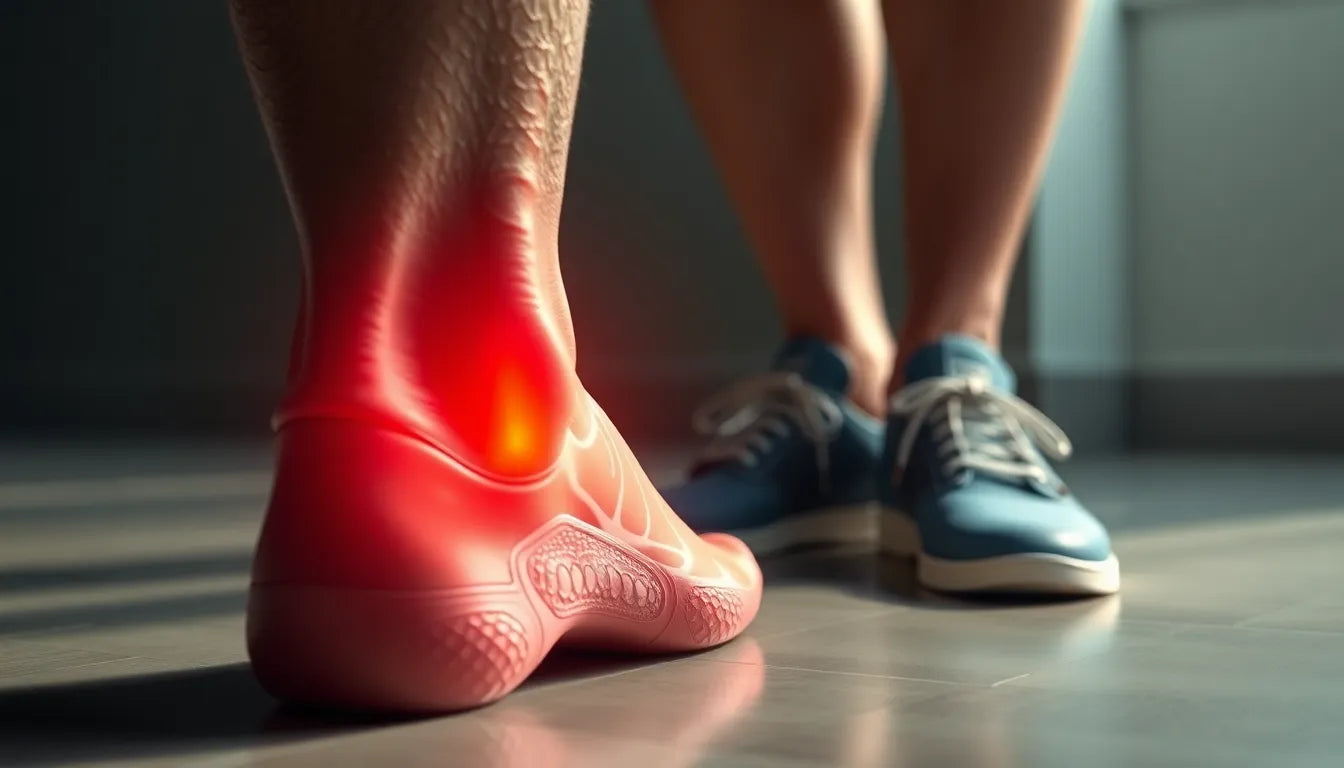Imagine waking up in the morning, the sun streaming through your window, but instead of feeling refreshed, you're met with a sharp, burning pain that shoots from your lower back through your hip and down your leg. This discomfort isn't just a morning nuisance; it lingers throughout the day, affecting your ability to sit, stand, or even walk comfortably. This is the reality for many individuals dealing with sciatic nerve pain in the hip and lower back, a condition that can significantly impact daily life and well-being.
Understanding sciatic nerve pain
Sciatic nerve pain, often referred to as sciatica, is a common condition characterized by pain that radiates along the path of the sciatic nerve. This nerve extends from the lower back through the hips and buttocks and down each leg, making it the longest and widest nerve in the human body. When this nerve becomes irritated or compressed, it can lead to symptoms such as sharp, burning pain, numbness, tingling, and even muscle weakness. These symptoms can vary in intensity and often worsen with prolonged sitting or sudden movements like coughing or sneezing.
The prevalence of sciatic nerve pain is notable, affecting a significant portion of the population at some point in their lives. It can arise from various causes, including disc herniation, spinal stenosis, or muscle-related issues such as piriformis syndrome. Regardless of the underlying cause, the impact of this pain can be debilitating, limiting mobility and reducing quality of life.
The importance of addressing sciatic nerve pain
Understanding the causes and symptoms of sciatic nerve pain is crucial for effective management and relief. Without proper knowledge, individuals may struggle to find the right treatment or mistakenly attribute their discomfort to other conditions. By recognizing the specific nature of sciatic pain, one can pursue targeted treatments that address the root cause rather than just alleviating symptoms temporarily.
Moreover, addressing sciatic nerve pain can lead to significant improvements in daily function and overall quality of life. With the right combination of self-care strategies, such as specific exercises and lifestyle adjustments, many individuals can experience relief and regain their ability to engage in activities they love. Proper management of sciatic nerve pain not only reduces discomfort but also empowers individuals to take control of their health and well-being.
In the following sections, we'll delve deeper into the causes, symptoms, and effective treatment strategies for sciatic nerve pain, providing you with the knowledge and tools to conquer this common yet challenging condition. By understanding and addressing the issue head-on, you can pave the way to a more comfortable and active life.
Understanding the causes of sciatic nerve pain
Sciatic nerve pain, or "iskiasnerven smerter i hoften og lænden," can arise from various underlying conditions that lead to nerve compression or irritation. One of the most common causes is disc herniation, where the soft inner core of a spinal disc protrudes through its outer layer, pressing against the adjacent nerve roots. This compression can lead to the characteristic pain that radiates from the lower back through the hip and down the leg. Similarly, spinal stenosis, a narrowing of the spaces within the spine, can also exert pressure on the sciatic nerve, exacerbating pain and discomfort.
Another condition that can mimic sciatic nerve pain is piriformis syndrome. This occurs when the piriformis muscle, located in the buttock region, spasms or becomes tight, compressing the sciatic nerve beneath it. Although the symptoms can be similar to true sciatica, piriformis syndrome is muscle-related, requiring different treatment approaches. Additionally, inflammation around the sciatic nerve can intensify symptoms, leading to increased pain and reduced mobility.
Identifying symptoms and achieving accurate diagnosis
Recognizing the symptoms of sciatic nerve pain is crucial for effective management. Typical symptoms include a sharp, burning sensation that travels from the lower back through the hip and down the leg, often accompanied by numbness, tingling, or muscle weakness. These symptoms can be exacerbated by prolonged sitting, standing, or sudden movements, such as coughing or sneezing.
To accurately diagnose the cause of sciatic nerve pain, it is essential to distinguish between different potential sources of discomfort. A comprehensive symptom checklist can aid in this process, helping individuals identify whether their pain is related to nerve compression, muscle issues, or inflammation. For instance, true sciatica, often due to disc herniation or spinal stenosis, typically involves nerve root compression, whereas piriformis syndrome involves muscle compression.
Conducting a differential diagnosis is vital for tailoring treatment strategies. A self-assessment guide can assist readers in evaluating their symptoms and considering potential causes. However, consulting a healthcare professional for a thorough evaluation and diagnosis is recommended, particularly if symptoms persist or worsen.
Effective strategies for managing sciatic nerve pain
Once the underlying cause of sciatic nerve pain is identified, implementing appropriate treatment strategies is essential for relief and recovery. Exercise and physical therapy play a pivotal role in reducing pressure on the sciatic nerve and improving mobility. Specific exercises, such as "knee-to-chest" stretches, can alleviate tension and enhance flexibility, promoting healing and pain reduction.

Lumbar support belt
Provides lower back support and relief for pain or tension. Adjustable for sciatica, herniated discs & more.
In addition to exercise, manual therapy techniques, including chiropractic and osteopathic adjustments, can provide significant relief, especially for acute symptoms. These therapies focus on realigning the spine and releasing tension in the surrounding muscles, thereby reducing nerve compression. For those seeking alternative treatments, acupuncture has shown promise in alleviating sciatic nerve pain by stimulating specific points to enhance energy flow and reduce inflammation.
In certain cases, medication may be necessary to manage pain and inflammation. Over-the-counter pain relievers or prescribed medications can be used to complement other treatment modalities. For severe or persistent cases, advanced interventions such as epidural injections or surgery might be considered, always under professional medical guidance.
By understanding the causes, accurately diagnosing symptoms, and implementing a comprehensive treatment plan, individuals can effectively manage sciatic nerve pain and improve their quality of life. In the next section, we'll explore additional treatment approaches, set realistic expectations for recovery, and address common questions about sciatic nerve pain management.
Comprehensive treatment approaches for sciatic nerve pain
Addressing "iskiasnerven smerter i hoften og lænden" effectively requires a multifaceted approach that combines various treatment modalities tailored to the individual's specific condition. Exercise and physical therapy are cornerstone strategies in managing sciatic nerve pain. Engaging in targeted exercises, such as the "knee-to-chest" stretch, can significantly reduce nerve tension and enhance flexibility. These exercises not only alleviate pain but also promote overall spine health, reducing the likelihood of future episodes.

Men's Posture Shirt™ - Black
Activates muscles and improves posture. Can help relieve back, neck, and shoulder pain.
Manual therapy techniques, including chiropractic and osteopathic adjustments, are highly beneficial for individuals experiencing acute sciatic nerve pain. These therapies aim to realign the spine and release muscle tension, thereby reducing nerve compression. Additionally, alternative treatments like acupuncture can complement traditional therapies by enhancing energy flow and reducing inflammation, offering a holistic approach to pain management.
Medication may be necessary for managing severe or persistent pain. Over-the-counter pain relievers, such as ibuprofen, can help reduce inflammation and provide temporary relief. In more severe cases, prescription medications or advanced interventions like epidural steroid injections may be recommended by healthcare professionals. These interventions should always be considered under medical guidance to ensure safety and efficacy.
Setting realistic expectations for recovery
When embarking on a treatment plan for sciatic nerve pain, it's crucial to set realistic expectations for recovery. While some individuals may experience relief within a few weeks, others may require a more extended period of consistent effort to achieve significant improvements. On average, noticeable relief from exercises and physical therapy can be expected within 4-6 weeks, though individual timelines may vary based on the severity of the condition and adherence to the treatment plan.
Emphasizing a holistic approach that combines multiple strategies can yield the best results. This includes maintaining a healthy lifestyle, practicing good posture, and staying active to prevent future occurrences of sciatic nerve pain. By committing to a comprehensive treatment plan and remaining patient, individuals can effectively manage their symptoms and improve their quality of life.
Frequently asked questions
What is the most common cause of sciatic nerve pain?
Disc herniation is a leading cause of sciatic nerve pain, but muscle-related issues like piriformis syndrome are also common contributors.
How long does it take to see improvement with exercises?
Consistent exercise can lead to noticeable relief in 4-6 weeks, although individual timelines may vary based on the severity of the condition and commitment to the exercise regimen.
When should I see a doctor for sciatic nerve pain?
If symptoms are severe, persistent, or worsening, it is crucial to seek professional medical advice for a thorough evaluation and tailored treatment plan.
Can lifestyle changes help manage sciatic pain?
Yes, maintaining a healthy weight, practicing good posture, and staying active can significantly reduce symptoms and prevent future episodes of sciatic nerve pain.
In conclusion, understanding and addressing "iskiasnerven smerter i hoften og lænden" through informed and proactive management can lead to significant improvements in quality of life. By exploring the outlined treatment options and consulting healthcare professionals for personalized advice, individuals can conquer sciatic nerve pain and regain their ability to engage in daily activities with comfort and ease.























